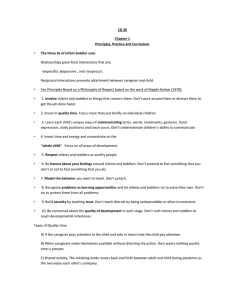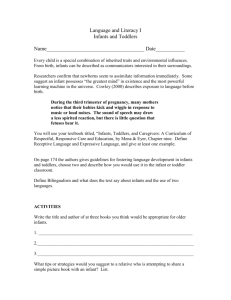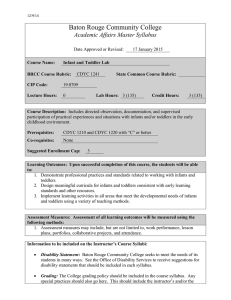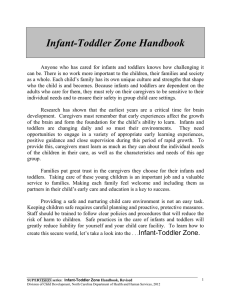CCE 135 Foundations of Early Learning
advertisement
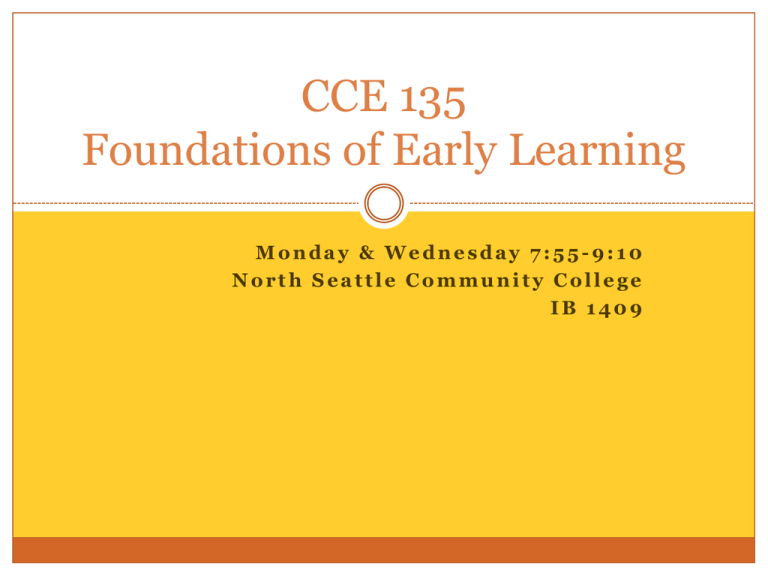
CCE 135 Foundations of Early Learning Monday & Wednesday 7:55-9:10 North Seattle Community College IB 1409 CCE 135: Foundations of Early Learning Candice Hoyt, Faculty (206) 715-1878 (until 9 pm) Office hours by appointment choyt@sccd.ctc.edu http://facweb.northseattle.edu/choyt Syllabus: • http://facweb.northseattle.edu/choyt/CCE135 Online – Angel: • http://northseattle.angellearning.com/ Monday Chapter 2 Education/Curriculum 1/11/10 Assessments Observations Learning Stories Using Assessments “Teaching” on the fly What infant-toddler education is NOT What infant-toddler education should be Curriculum Role of adult Praise Positive Reinforcement Feedback Modeling Readings 1 & 2 Learning Story check-in SQ topics Wrap Up Infants, Toddlers, and Caregivers A Curriculum of Respectful, Responsive Care and Education Janet Gonzalez-Mena and Dianne Widmeyer Eyer CHAPTER 2 Education/Curriculum What infant-toddler education is NOT What infant-toddler education should be Curriculum Role of adult What infant-toddler education is NOT (pp. 26-28) Infant stimulation Television, toys AAP recommends no TV for children under 2 (including TV in the environment) Television and toy “educational” claims are typically unproved Other stimulation programs unproved to help in typically developing children Baby sitting Instinct, play & safety focus Preschool Lessons, expectations/goals, restrictions on material use Proud of generic output Toddlers “look incompetent because they don’t conform to the expectations” (p. 27) Parents, teachers frustrated Waiting for toddlers to grow Wanting them to “do it right” “Tolerate them in the meantime” (p. 27) Toddlers frustrated Want to do what’s interesting Want to please adults and achieve but are set up to fail What infant-toddler education should be No expected activities or outcomes Curriculum = “plan for learning and development that is all inclusive and centers on connections and relationships” (p. 28) Planned and unplanned activities Children learn through genuine experiences & problem-solving Lessons and restrictions on how to use materials inhibit true experiences and problem-solving opportunities How? “Babies need to discover that they can influence the people and things around them” – most important for learning at any age! (p. 26) And “to perceive their own involvement” (p. 26) – pride and intellectual results Television does not do this Computer games and toys may Still not as open-ended as interacting with real materials naturally occurring in the child’s world Curriculum (p. 30) Framework Philosophy on how children learn Teaching methodology/ behavior Goals or desired results Teaching Ideas for activities & environment Understand ZPD (Zone of Proximal Development -> scaffolding) Knowledgeable about: Mission statement or… ? Holistic Goals in areas: Typical development Atypical development Diversity Strategies to adapt activities/environment for each of these Vision statement Policies “How We Teach” Cognitive Physical Social-Emotional Interpersonal Intrapersonal Cultural/societal Spiritual Creative / aesthetic “Normal” not necessarily a goal Role of Adult Role of Adult (Figure 2.1, p. 35) Determining optimum stress levels… 1. 2. 3. 4. [Don’t abandon or force when the child is too frustrated or it is too difficult] Providing attention…. Providing feedback… Modeling Assessments Observations Learning Stories Using Assessments Observations Anecdotal records Objective Some exact Some informal narrative— notes immediately or later Running records Objective, non-judgmental Exact Comprehensive Documentation Objective Exact visual/audio Media recording Points-in-time Zone of Proximal Development (ZPD) Use the knowledge you get from observing What child can do next with tiny bit of your involvement “Not to get rid of frustration but to keep the child working on the problem” (p. 36). What to do to with the child Learning Stories Learning Stories Document exactly Write subjectively “Analyze” professionally Documentation need: caregivers, families & the child Narrative/description: Time, Recording media, Input from … What child is doing What they can do Best when you have help “analyzing” what you have seen Using Assessments Inclusion of families Review/compare to … What is happening at home Previous observations at school or home Deeper understanding of what this means for The child: Developmentally Socially (pride) The parents: Their view on how/why this is important Connect with the parents social-emotionally Daily log (infants especially) Charts (Appendix B) Assessment: know what to expect for typical child Dramatic difference from “typical” may need intervention Family can confirm (sometimes different at school than at home) Next steps What’s typically next developmentally Use ZPD determine what to try –new materials/ environment/experiences Within reach of typical child “Teaching” on the fly Praise Positive Reinforcement Feedback Modeling Praise “Development isn’t about winning and losing” (p. 32) Praise (pp. 38-39) Expresses what you value Communicates need to meet your goals or expectations to please you “I like the way you…” “Good job.” Article: Alfie Kohn, “Five Reasons to Stop Saying ‘Good Job!’” www.alfiekohn.org/parenting/gj.htm 1. Manipulating children 2. 3. Creating praise junkies Stealing a child’s pleasure 4. Telling them what to feel Losing interest 5. For our convenience Without attention Reducing achievement Less likely to take risks Positive Reinforcement Say nothing Specify valued behavior: The child may already have acknowledged internally They don’t always need our feedback “Rewards” Intangible are best Attention, verbalizing Goal is intrinsic value “Acknowledging the child’s own inner delight” (p. 39) – make sure you get it right “You stacked five blocks!” “You put all your dishes away without being asked.” When you don’t know what to say: High five/ thumbs up. Questions: Open-ended Express genuine interest Once the child “gets it”, stop reinforcing it Feedback Helping children understand the effects of their actions Stay quiet until necessary Interpersonal Make sure you interpret correctly before providing feedback Say, “I think he ran away because you shouted at him.” Modified from p. 40 “I think” keeps you neutral Achievement Facilitate using ZPD Okay to give up on task that is too hard; find appropriate alternative Modeling Best way to teach children, parents and teachers! Intrapersonal Expressing genuine emotions Taking care of yourself (timeout or eating, etc) Interpersonal Gentleness Turn-taking Standing up for yourself Saying you’re sorry What happens when you make a mistake: apologize for… Yelling Taking/ruining something Infants, Toddlers, and Caregivers A Curriculum of Respectful, Responsive Care and Education Janet Gonzalez-Mena and Dianne Widmeyer Eyer READING 1 & 2 Readings 1 & 2 “As we value inner directedness in a child, we prefer gentle validations to instructions, to criticism, and even to praise” (Reading 1, p. 6). Use: Occasional reflections Empathy Smile to “convey our pleasure in his success” (Reading 1, p. 6) Children who are “’refueled’ by such caring experiences” (Reading 1, p. 6) can independently play so parents can too Readings 1 & 2 Infants in group care: Many cultures (NZ, e.g.) believe infants need significant time with peers Childcare is publicly funded—available to all “Set up to serve the child’s needs” (Reading 1, p. 8) Child can “explore and interact with other infants” (Reading 1, p. 8) Lesson planning for infants (Reading 2) Prepare for adaptations based on infant response Don’t use if it doesn’t fit infants’ needs & interests Plan and re-plan to match & develop: Relationship between infant & teacher Interest of child Aptitude of child Learning Stories Questions? Sequence Presentation Topic Selections SQ 1 topic selection (decide by Monday 1/11) Team A: Chapter 5 – Attachment: Co-sleeping Team B: Chapter 6 – Perception: Young Child’s Brain / Windows of Opportunity Team C: Chapter 7 – Motor Skills: Infant Swimming Team D: Chapter 8 – Cognition: Sign Language SQ 2 topic selection (decide by Monday 2/1) Team A: Chapter 9 – Language: Sign Language Team B: Chapter 10 – Emotions: Long-term affects of attachment Team C: Chapter 11 – Social Skills: ____________ Team D: Chapter 12 & 13 – Physical & Social Environments: ____________ Wrap Up Wednesday 1/13 Wednesday 1/20 Due… Read Ch 3; Reading 3 Post DQ 3: Ch 3, R 3 Post DQ 1 replies (2+) Due… A 01a replies (to each person’s Conscious Care) DQ 04: Ch 4, R 4, R 7 DQ 2 replies (2) DQ 3 replies (2) In class… Chapter 3; Reading 3 Monday 1/18 Holiday – no class In class… Ch 4, Readings 4 & 7 Conscious Care reflection Learning Story questions

